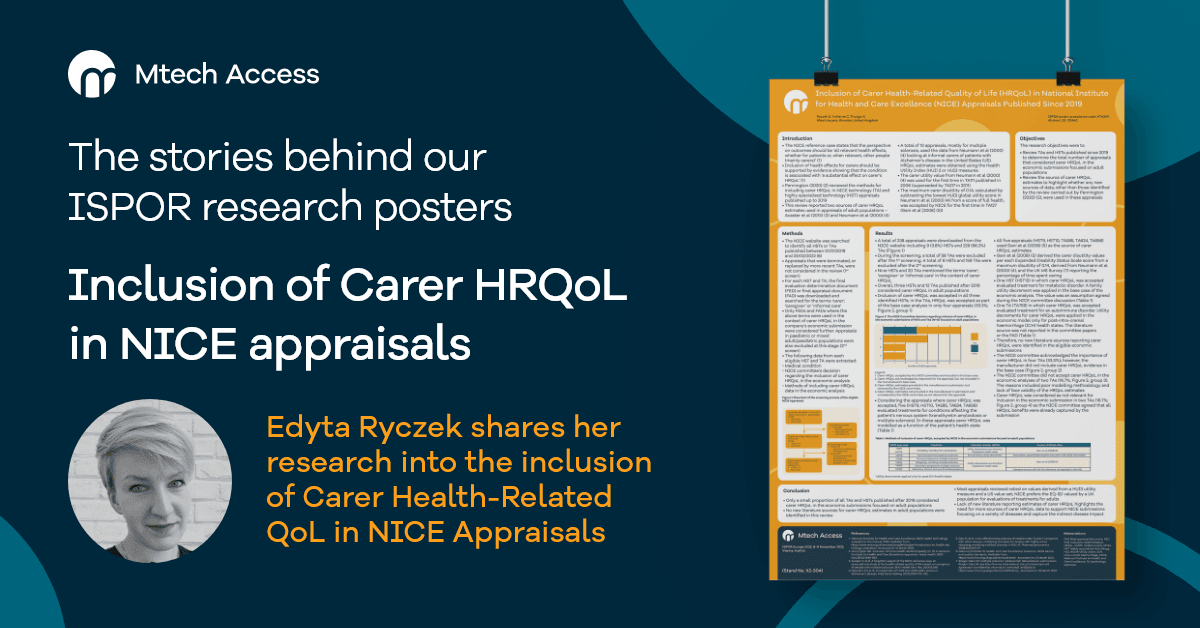
We speak to Edyta Ryczek (Associate Health Economist) to get the story behind the poster: ‘Inclusion of Carer Health-Related Quality of Life (HRQoL) in National Institute for Health and Care Excellence (NICE) Appraisals Published Since 2019’. Edyta worked with Elizabeth Thurgar (Director – Health Economist) and Catrin Treharne (Director – Health Economics), to research, develop and co-author the poster for presentation at ISPOR.
In all, we presented 7 independent research posters at ISPOR Europe, from 7th-9th November 2022. In this series of interviews we sit down with poster authors to learn a bit more about their research.

What topic does your poster explore?
The poster focuses on people that are the closest to patients and are likely to be affected by a patient’s disease or condition, i.e. informal carers.
Carers are often family members, children or parents of children, or patients’ friends. The poster evaluates carers’ health-related quality of life (HRQoL), which is likely to be affected as a consequence of living or caring for an affected patient.
Our research focused on the technology and highly specialised technology appraisals that are included in the remit of work carried out by the National Institute for Health and Care Excellence (NICE) in the United Kingdom. Our research prioritised adult populations, as previous research highlighted a low number of appraisals in which carers’ HRQoL was considered.
What inspired you to pursue this topic?
The research was inspired by a journal publication that I presented during our internal Journal Club. The journal club takes place every month and is an opportunity for Health Economics team members to share and discuss research. At each meeting, one of the team takes the lead and chooses a journal publication of interest to present. They summarise the research and present it to the team for wider discussion.
Earlier this year, I introduced a review by Pennington (2020), which was focused on carers’ HRQoL in NICE appraisals published up to 2019.
During my preparation, I was surprised by the low number of appraisals that considered carers’ well-being in conditions that affected adults only (10 out of 27 appraisals). In addition, Pennington (2020) highlighted only a limited number of sources of data for carers’ HRQoL that were used in these appraisals (two literature sources).
Therefore, I decided to pursue this topic further to report on the inclusion of carers’ HRQoL in NICE appraisals focused on adult populations published after 2019. I aimed to evaluate the number of appraisals that considered carers’ HRQoL and whether new literature sources of carer HRQoL estimates were utilised.
How did you and your co-authors work together to conduct the research and develop the poster?
I shared the research idea with Elizabeth and Catrin following my presentation at Journal Club.
I was responsible for the initial research. This involved searching for NICE appraisals, checking all company submissions and other NICE committee papers. The process required good organisation of work, and my systematic review skills were highly utilised!
Following the screening of the papers, I performed a simple data extraction of information from the appraisals that was later used for the development of the poster.
Elizabeth and Catrin were both present during all stages of the research and development of the poster. We spent many afternoons discussing the progress and my findings as well as planning the next steps for the research. Their expertise was invaluable!
For you, what was the most interesting aspect of your research?
Going through the company submissions and the NICE committee papers; it was interesting to follow the appraisal process from the beginning and notice all the discussions had along the way. This gave me a better understanding of the complexity of the NICE process, more so than simply attending NICE committee meetings.
However, there is a lack of methodological guidance for the manufacturers in situations when inclusion of carer HRQoL is appropriate. That was noticeable when going through the process of screening the appraisals, especially since the inclusion of carer HRQoL estimates can have a substantial impact on the results of the health economic model. However, it is important to note the consequences of routinely including carer HRQoL. For example, there can be difficulties accurately comparing appraisals that considered carer HRQoL estimates with those that did not.
Were the results as you anticipated when you began your research? Were there any surprises?
I did not expect any particular results; I started the project with an open mind and curiosity. However, considering the results of the previously mentioned paper by Pennington (2020), finding a greater number of appraisals focused on adult populations and any new publications reporting new estimates for carer HRQoL would be an indication of the progress in this area of health economics.
However, a couple of research findings are worth highlighting.
Firstly, company submissions that focused on diseases other than those affecting the patient’s nervous system did not often consider carers’ HRQoL. This is likely to be driven by the availability of estimates for carer HRQoL. Secondly, most papers relied on the estimates derived from a single value accepted by NICE over 15 years ago in 2006. It is unclear whether more robust evidence was published in recent years and the estimate is the best possible guess to value carers’ HRQoL.
What was your most important conclusion?
Informal care is an important aspect of the support system for patients with chronic diseases or those recovering from a disease.
Therefore, it is important to consider whether the inclusion of carer HRQoL in the health economic modelling is appropriate at the early stages of the model conceptualisation. Early assessment of the feasibility of including carers HRQoL, considering the available evidence, will allow implementation of the best methodology.
In addition, as the health technology assessment is a collaborative process, the voice of patients should be included as part of the appraisal process.
What would you like to explore next?
I believe there is a lot of potential for further research.
It would be interesting to explore whether any new sources of carer HRQoL estimates were recently published, but not yet utilised in the NICE appraisals. Pennington (2020) highlighted only two sources of estimates that were used in the NICE appraisals focused on adults, whereas our findings highlighted no new literature sources. Therefore, a systematic review looking for newly published carer HRQoL estimates, focusing on the population of the United Kingdom, would be an important next step.
In addition, it would be interesting to see whether any new literature sources have been utilised in the NICE appraisals for other populations such as paediatric or mixed populations.
What have you learnt that you can apply to future client projects?
This research has seen us develop a good understanding of the disease areas and carer HRQoL estimates that were utilised in the NICE appraisals, particularly those focused on adult populations. This knowledge will help to facilitate further discussions with clients regarding the inclusion of carer HRQoL in their health economic models.
In particular, our research has highlighted the importance of utilising a robust methodology to incorporate HRQoL estimates.
View the poster here.
If you would like to discuss this research with the poster authors or to learn more about how we can support you with health economic modelling, systematic review and/or health technology assessment, email info@mtechaccess.co.uk.


